Quantifying Damages to Soil Health and Emissions from Land Development in the State of Illinois (USA)
Abstract
1. Introduction
The Role of Soils in Illinois’ Soil Health and Climate Actions
2. Materials and Methods
3. Results
3.1. SOC Storage and Value by County and Soil Order for Illinois (IL)
3.2. SIC Storage and Value by County and Soil Order for Illinois (IL)
3.3. TSC (SOC + SIC) Value and Storage by County and Soil Order for Illinois (IL)
3.4. Land Use/Land Cover in the State of Illinois (IL) in 2016 and the Soil Health Continuum
3.5. Land Use/Land Cover Change in the State of Illinois (IL) from 2001 to 2016 and the Soil Health Continuum Dynamics
4. Discussion
4.1. Significance of the Results for Illinois’ Soil Health Actions and Soil Health in General
4.2. Damage to Soil Health and Scale Considerations
4.3. Redefining the Soil Health Continuum at the Landscape Level
4.4. The Legal Aspects of the Soil Health Legislative Actions
4.4.1. Benefits and Limitations of Soil Health Legislative Actions
4.4.2. Refining Soil Health Legislative Actions
4.5. Study Implications in a Broader Context
- An overall decrease in the land identified as hay/pasture occurred from 2001 to 2016 in the State, affecting all soil orders (Table 3). The loss of hay/pasture area results in an overall reduced production capacity from this land use/cover (which addresses SDG 2: Zero Hunger);
- Although land development occurred in all six soil orders in the State, the most productive agricultural soils (e.g., Alfisols and Mollisols) and the C-rich Histolsols experienced the highest conversions (addressing SDG 12: Responsible Consumption and Production);
- The State has legislation on clean energy with the goal of 100% renewable energy by 2050 (Public Act 102-0662), but it does not address other sources of GHG emissions (e.g., soil GHG emissions) [4]. Land development in IL has caused damage to soil health due to the loss of soil C and subsequent emission of carbon dioxide (CO2). There is only a small amount of land (less than 1% of the total land area) that can be used for nature-based C sequestration techniques [27] (addressing SDG 13: Climate Action);
- Overall degradation of soil resources (pedodiversity) has occurred in all soil orders of IL in the past and recently over the period 2001–2016 due to changes in land use/land cover, for example, reductions in woody and emergent herbaceous wetlands and other herbaceous land covers (Table 3). There were also reductions in the total forest area. In addition to a reduced forest production capacity, the decrease in deciduous and evergreen forests shrinks existing C sinks, allowing for more GHG emissions and pollutants in the atmosphere (addressing SDG 15: Life on Land).
5. Conclusions
Supplementary Materials
Author Contributions
Funding
Data Availability Statement
Acknowledgments
Conflicts of Interest
Glossary
| B | Billion |
| BS | Base saturation |
| CF | Carbon footprint |
| CCA | Climate Change Adaptation |
| CO2 | Carbon dioxide |
| COP | Conference of the Parties |
| ED | Ecosystem disservices |
| ES | Ecosystem services |
| EPA | Environmental Protection Agency |
| EU | European Union |
| GHG | Greenhouse Gases |
| IL | Illinois |
| L&D | Loss and damage |
| LULC | Land use/land cover |
| LULCC | Land use/land cover change |
| M | Million |
| N | North |
| NOAA | National Oceanic and Atmospheric Administration |
| NRCS | Natural Resources Conservation Service |
| PPP | Polluter-pays-principle |
| RCCA | Reverse Climate Change Adaptation |
| SC-CO2 | Social cost of carbon emissions |
| SDGs | Sustainable Development Goals |
| SOC | Soil organic carbon |
| SIC | Soil inorganic carbon |
| SOM | Soil organic matter |
| SSURGO | Soil Survey Geographic Database |
| STATSGO | State Soil Geographic Database |
| TSC | Total soil carbon |
| USDA | United States Department of Agriculture |
| W | West |
| WIM | Warsaw International Mechanism |
References
- Lehmann, J.; Bossio, D.A.; Koge-Knabner, I.; Rillig, M.C. The concept and future prospects of soil health. Nat. Rev. Earth Environ. 2020, 1, 544–553. [Google Scholar] [CrossRef] [PubMed]
- Karlen, D.L.; Veum, K.S.; Sudduth, K.A.; Obrycki, J.F.; Nunes, M.R. Soil health assessment: Past accomplishments, current activities, and future opportunities. Soil Tillage Res. 2019, 195, 104365. [Google Scholar] [CrossRef]
- Illinois Public Act 101-0484. Amendment to the Soil and Water Conservation Districts Act. 2019. Available online: https://www.ilga.gov/legislation/fulltext.asp?DocName=&SessionId=108&GA=101&DocTypeId=HB&DocNum=2737&GAID=15&LegID=118981 (accessed on 1 May 2023).
- Illinois Public Act 102-0662. Climate and Equitable Jobs Act. 2021. Available online: https://www.ilga.gov/legislation/publicacts/102/PDF/102-0662.pdf (accessed on 1 May 2023).
- Soil Science Society of America. n.d. USDA. Drummer—Illinois State Soil. Available online: https://www.soils4teachers.org/files/s4t/k12outreach/il-state-soil-booklet.pdf (accessed on 1 May 2023).
- Mikhailova, E.A.; Zurqani, H.A.; Post, C.J.; Schlautman, M.A.; Post, C.J. Soil diversity (pedodiversity) and ecosystem services. Land 2021, 10, 288. [Google Scholar] [CrossRef]
- Soil Survey Staff, Natural Resources Conservation Service, United States Department of Agriculture. n.d.a. Soil Survey Geographic (SSURGO) Database. Available online: https://nrcs.app.box.com/v/soils (accessed on 10 September 2022).
- The United States Census Bureau. TIGER/Line Boundary Shapefiles. 2018. Available online: https://www.census.gov/geographies/mapping-files/time-series/geo/tiger-line-file.2018.html (accessed on 10 September 2022).
- The Nature Conservancy. An Assessment of the Impacts of Climate Change in Illinois. Available online: https://www.nature.org/content/dam/tnc/nature/en/documents/IL_Climate_Assessment_2020_Executive_Summary.pdf (accessed on 1 May 2023).
- EPA—United States Environmental Protection Agency. What climate change means for Illinois. EPA 430-F-16-015. August 2016. Available online: https://19january2017snapshot.epa.gov/sites/production/files/2016-09/documents/climate-change-il.pdf (accessed on 1 May 2023).
- Mehra, P.; Singh, B.; Kunhikrishnan, A.; Cowie, A.L.; Bolan, N. Soil health and climate change: A critical nexus. Manag. Soil Health Sustain. Agric. 2018, 1, 39–68. [Google Scholar]
- Melillo, J.M.; Frey, S.D.; DeAngelis, K.M.; Werner, W.J.; Bernard, M.J.; Bowles, F.P.; Pold, G.; Knorr, M.A.; Grandy, A.S. Long- term pattern and magnitude of soil carbon feedback to the climate system in a warming world. Science 2017, 358, 101–105. [Google Scholar] [CrossRef] [PubMed]
- Toor, G.S.; Yang, Y.Y.; Das, S.; Dorsey, S.; Felton, G. Soil health in agricultural ecosystems: Current status and future perspectives. Adv. Agron. 2021, 168, 157–201. [Google Scholar]
- Borrelli, P.; Robinson, D.A.; Panagos, P.; Lugato, E.; Yang, J.E.; Alewell, C.; Wuepper, D.; Montanarella, L.; Ballabio, C. Land use and climate change impacts on global soil erosion by water (2015–2070). Proc. Natl. Acad. Sci. USA 2020, 117, 21994–22001. [Google Scholar] [CrossRef] [PubMed]
- Soil4Climate, Inc., Healthy Soils Legislation. Available online: https://policy.soil4climate.org (accessed on 1 June 2023).
- Delmendo, M.N.; Sipos, Y.; Montgomery, D.R.; Cole, R.P.; Otten, J.J. The scope of U.S. state soil health legislation: A mixed-methods policy analysis. J. Agric. Food Syst. Community Dev. 2021, 10, 69–90. [Google Scholar] [CrossRef]
- Stevens, A.W. Review: The economics of soil health. Food Policy 2018, 80, 1–9. [Google Scholar] [CrossRef]
- Shen, R.F.; Teng, Y. The frontier of soil science: Soil health. Pedosphere 2023, 33, 6–7. [Google Scholar] [CrossRef]
- EPA—United States Environmental Protection Agency. 2016; The Social Cost of Carbon. EPA Fact Sheet. Available online: https://19january2017snapshot.epa.gov/climatechange/social-cost-carbon_.html (accessed on 15 September 2022).
- Guo, Y.; Amundson, R.; Gong, P.; Yu, Q. Quantity and spatial variability of soil carbon in the conterminous United States. Soil Sci. Soc. Am. J. 2006, 70, 590–600. [Google Scholar] [CrossRef]
- Groshans, G.R.; Mikhailova, E.A.; Post, C.J.; Schlautman, M.A.; Zhang, L. Determining the value of soil inorganic carbon stocks in the contiguous United States based on the avoided social cost of carbon emissions. Resources 2019, 8, 119. [Google Scholar] [CrossRef]
- Multi-Resolution Land Characteristics Consortium—MRLC. Available online: https://www.mrlc.gov/ (accessed on 1 September 2021).
- ESRI (Environmental Systems Research Institute). ArcGIS Pro 2.6. Available online: https://pro.arcgis.com/en/pro-app/2.6/get-started/whats-new-in-arcgis-pro.htm (accessed on 1 March 2022).
- Mikhailova, E.A.; Groshans, G.R.; Post, C.J.; Schlautman, M.A.; Post, G.C. Valuation of soil organic carbon stocks in the contiguous United States based on the avoided social cost of carbon emissions. Resources 2019, 8, 153. [Google Scholar] [CrossRef]
- Mikhailova, E.A.; Groshans, G.R.; Post, C.J.; Schlautman, M.A.; Post, G.C. Valuation of total soil carbon stocks in the contiguous United States based on the avoided social cost of carbon emissions. Resources 2019, 8, 157. [Google Scholar] [CrossRef]
- Soil Survey Staff, Natural Resources Conservation Service, United States Department of Agriculture. Photos of Soil Orders. Available online: https://www.nrcs.usda.gov/wps/portal/nrcs/detail/soils/edu/?cid=nrcs142p2_053588 (accessed on 20 September 2022).
- Keesstra, S.; Nunes, J.; Novara, A.; Finger, D.; Avelar, D.; Kalantari, Z.; Cerdà, A. The superior effect of nature based solutions in land management for enhancing ecosystem services. Sci. Total Environ. 2018, 610–611, 997–1009. [Google Scholar] [CrossRef] [PubMed]
- Sanderman, J.; Hengl, T.; Fiske, G.J. Soil carbon debt of 12,000 years of human land use. Proc. Natl. Acad. Sci. USA 2017, 114, 9575–9580. [Google Scholar] [CrossRef] [PubMed]
- Kersey, J.; Myrold, D. Response of soil health indicators to organic matter removal and compaction manipulations at six LTSP sites in the Western US. For. Ecol. Manag. 2021, 490, 119104. [Google Scholar] [CrossRef]
- U.S. Bureau of the Census. Statistical Abstract of the United States: 1991; U.S. Bureau of the Census: Washington, DC, USA, 1991; p. 201. Available online: https://www.census.gov/library/publications/1991/compendia/statab/111ed.html (accessed on 10 June 2023).
- Agricultural Lands: Greenhouse Gases: Healthy Soil Program, SB-1350. 2016. Sacramento, CA: California Legislative Information. Available online: https://leginfo.legislature.ca.gov/faces/billNavClient.xhtml?bill_id=201520160SB1350 (accessed on 2 May 2023).
- Dumanski, J. Evolving concepts and opportunities in soil conservation. Int. Soil Water Conserv. Res. 2015, 3, 1–14. [Google Scholar] [CrossRef]
- Agriculture Improvement Act of 2018, Public Law 115–334. 115th Congress. Government Printing Office: Washington, DC, USA, 2018. Available online: https://www.govinfo.gov/link/plaw/115/public/334?link-type=pdf (accessed on 2 May 2023).
- Abnett, K. EU set to swerve binding targets to improve soil health. Reuters June 30, 2023. Available online: https://www.reuters.com/world/europe/eu-set-swerve-binding-targets-improve-soil-health-2023-06-30/ (accessed on 30 June 2023).
- UN. Transforming Our World: The 2030 Agenda for Sustainable Development; United Nations: New York, NY, USA, 2015. [Google Scholar]
- Lal, R. United Nations Food Systems Summit: What is the role of soil health in putting the Sustainable Development Goals on track? J. Soil Water Conserv. 2021, 76, 105A–107A. [Google Scholar] [CrossRef]
- Yin, C.; Zhao, W.; Pereira, P. Soil conservation service underpins sustainable development goals. Glob. Ecol. Conserv. 2022, 33, e01974. [Google Scholar] [CrossRef]
- Report of the Inter-Agency and Expert Group on Sustainable Development Goal Indicators. 2016. Available online: https://digitallibrary.un.org/record/821651?ln=en (accessed on 9 May 2023).
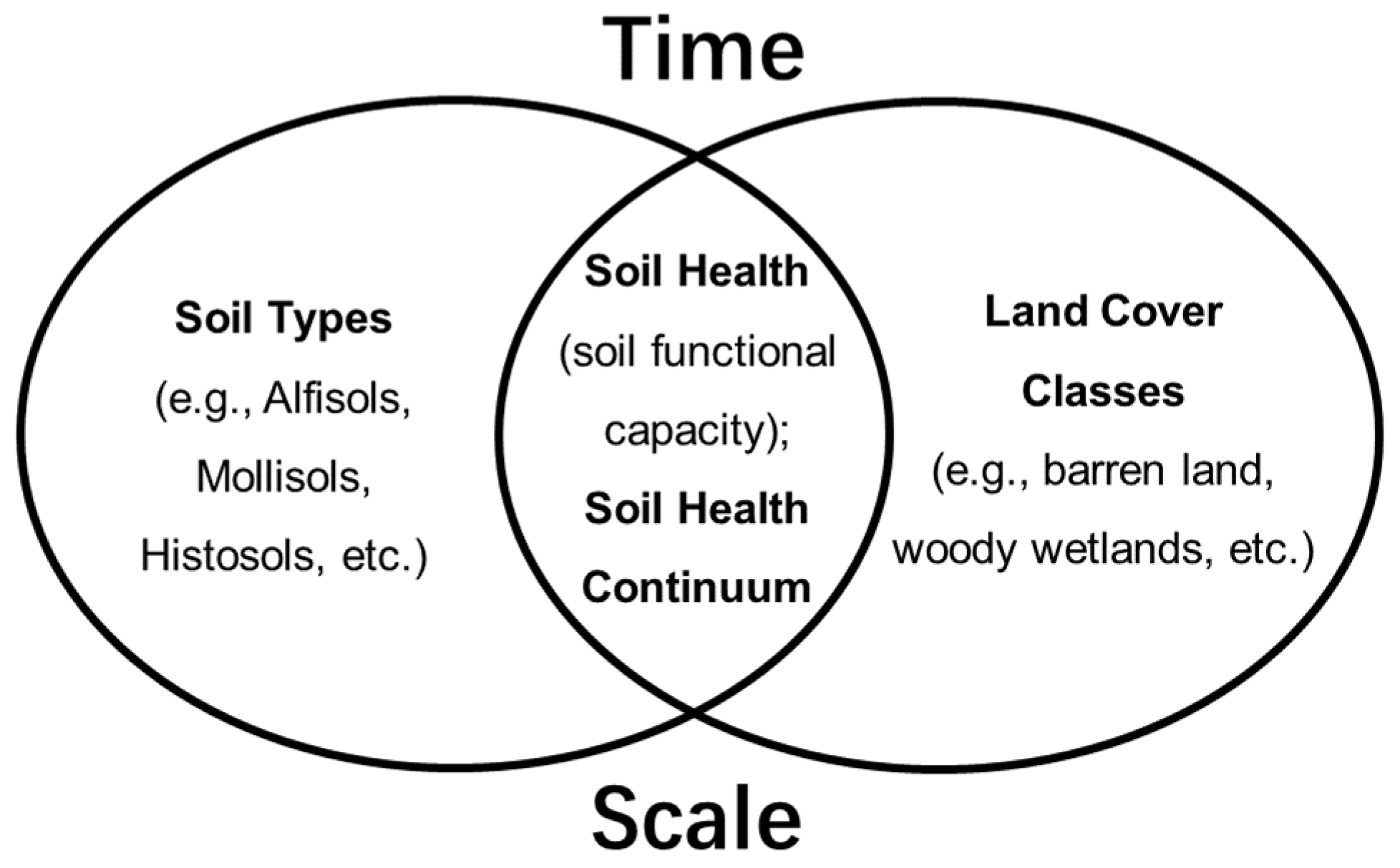

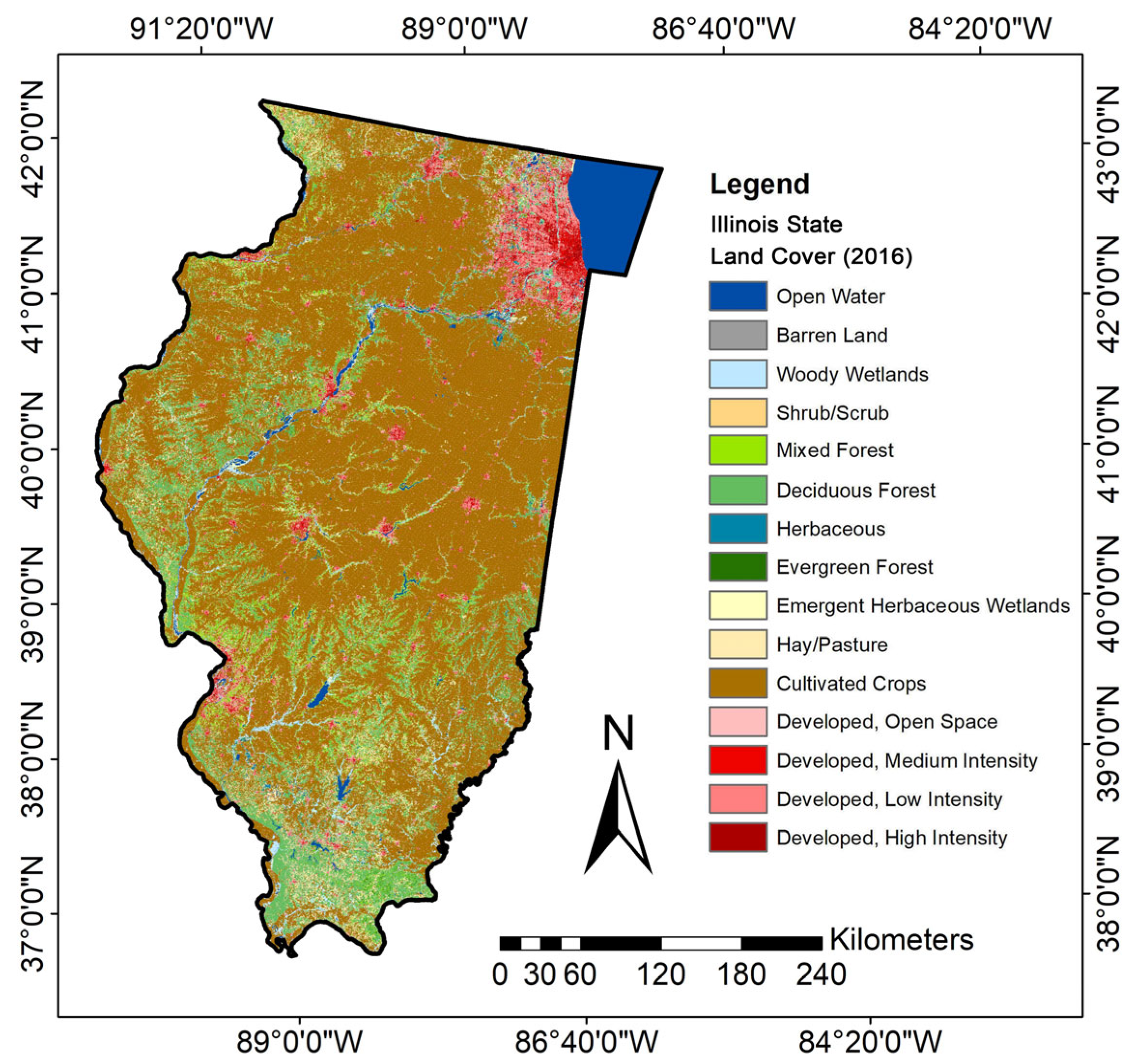

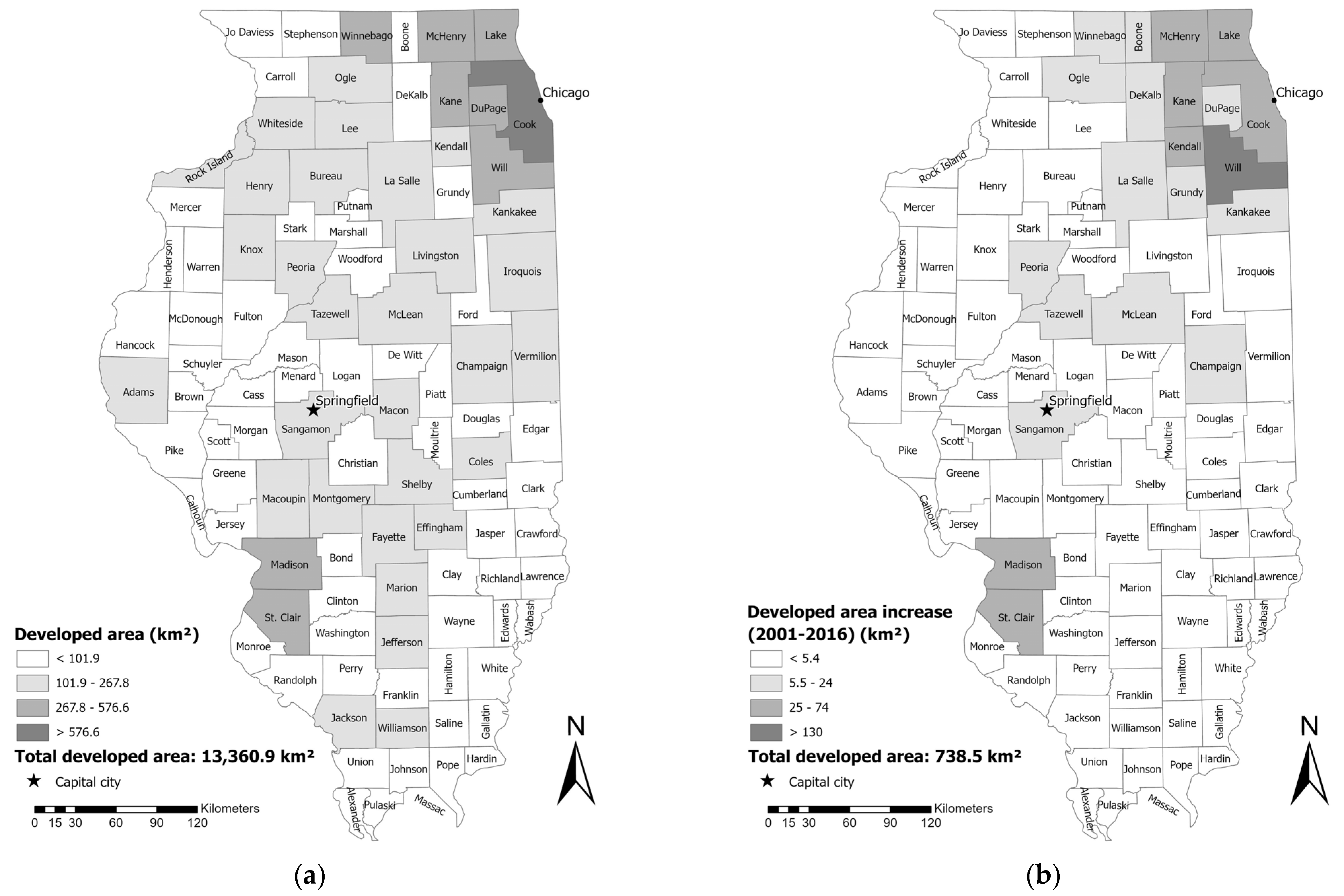
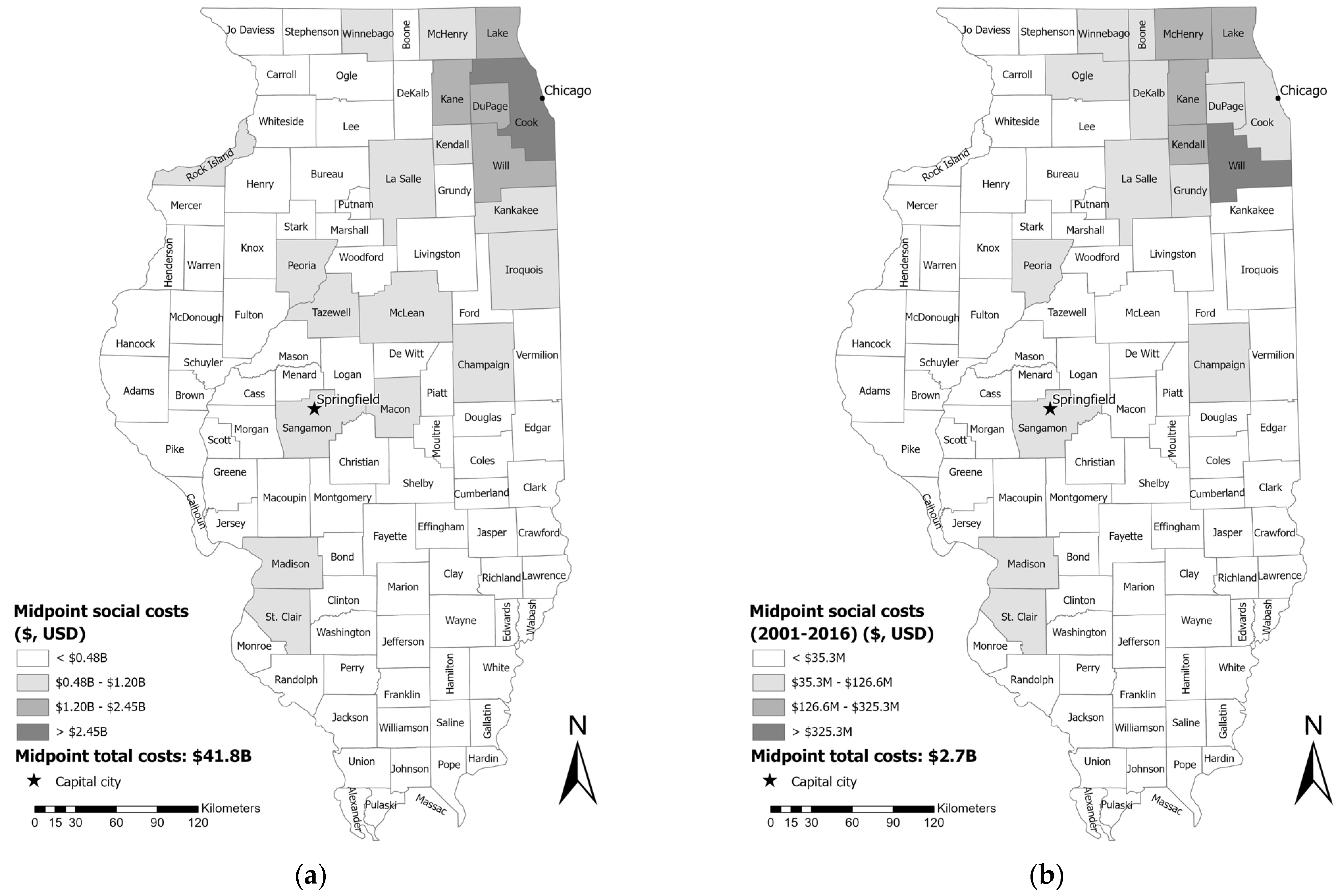
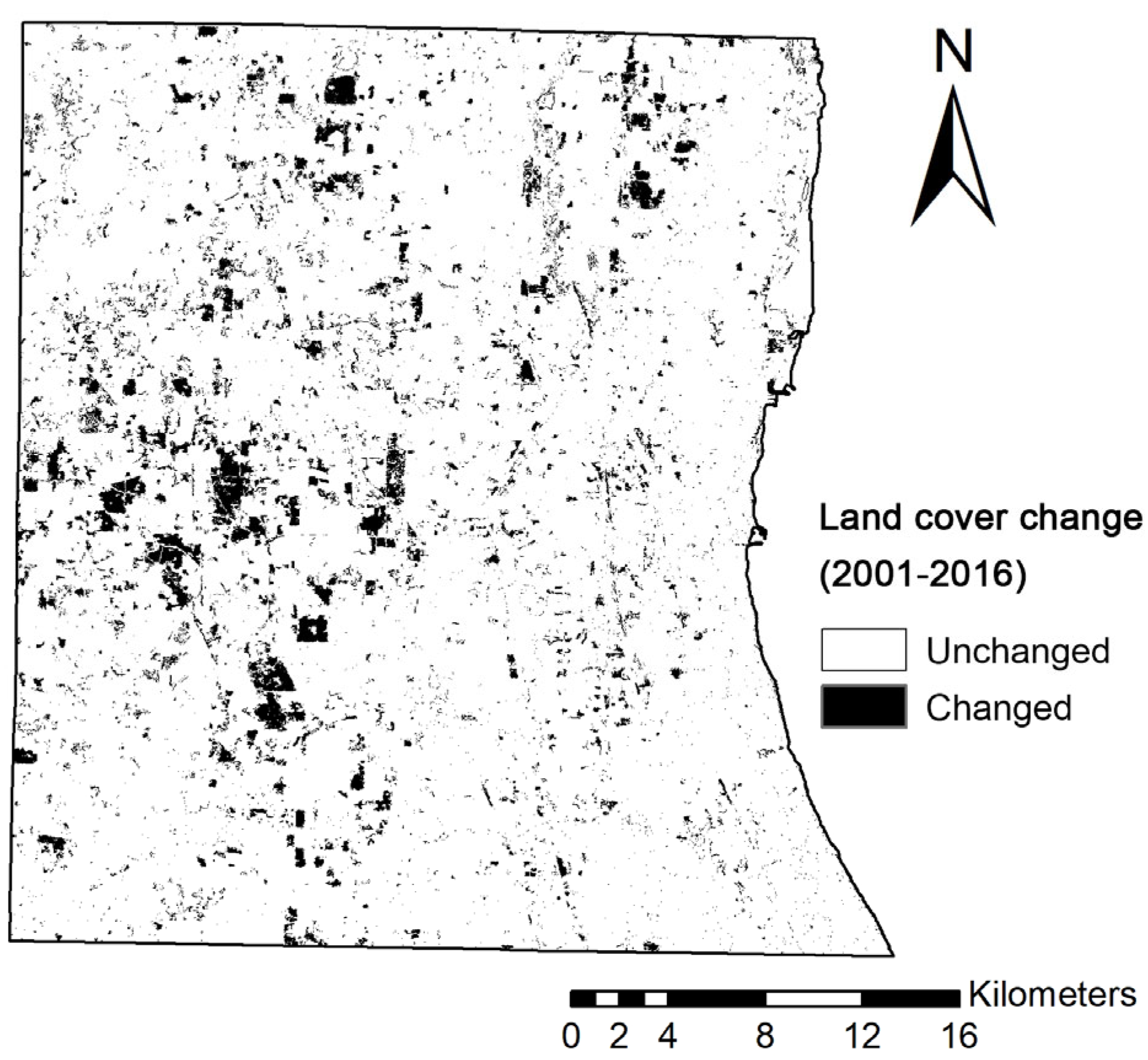
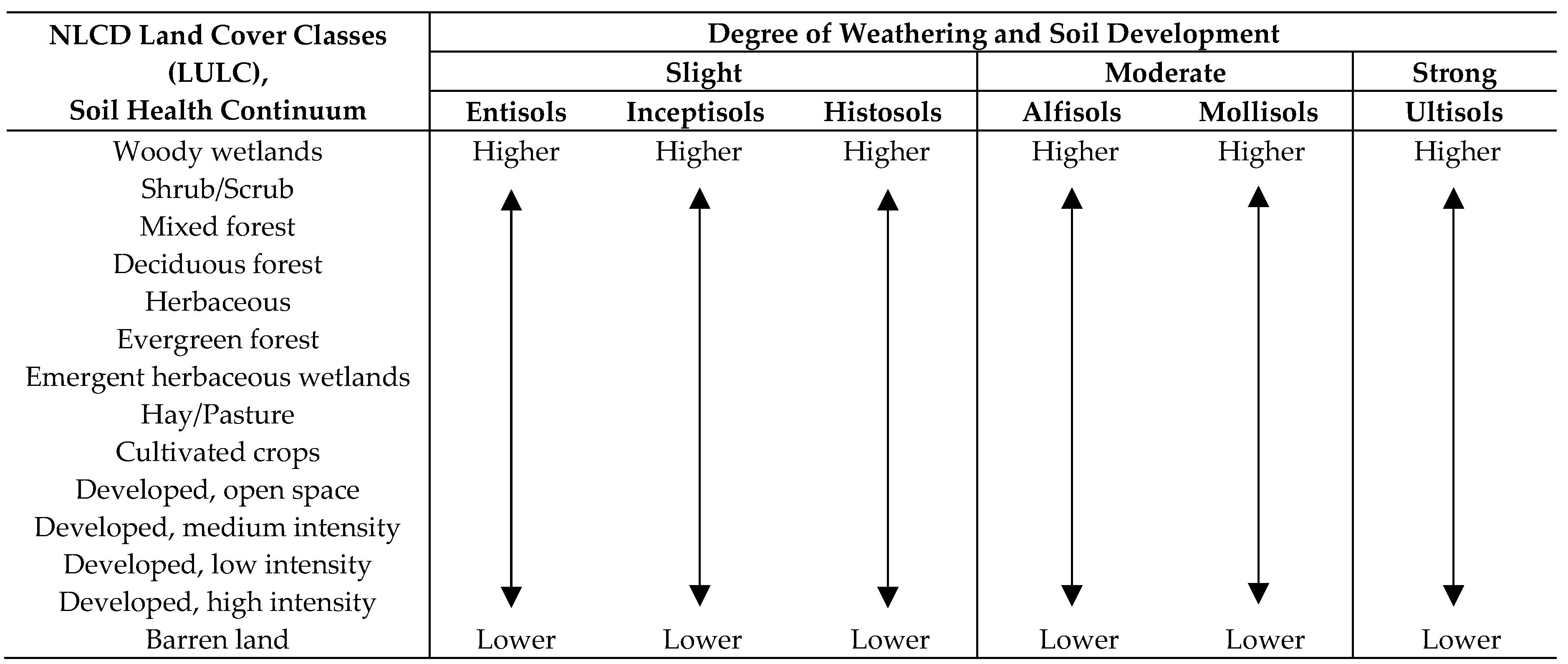
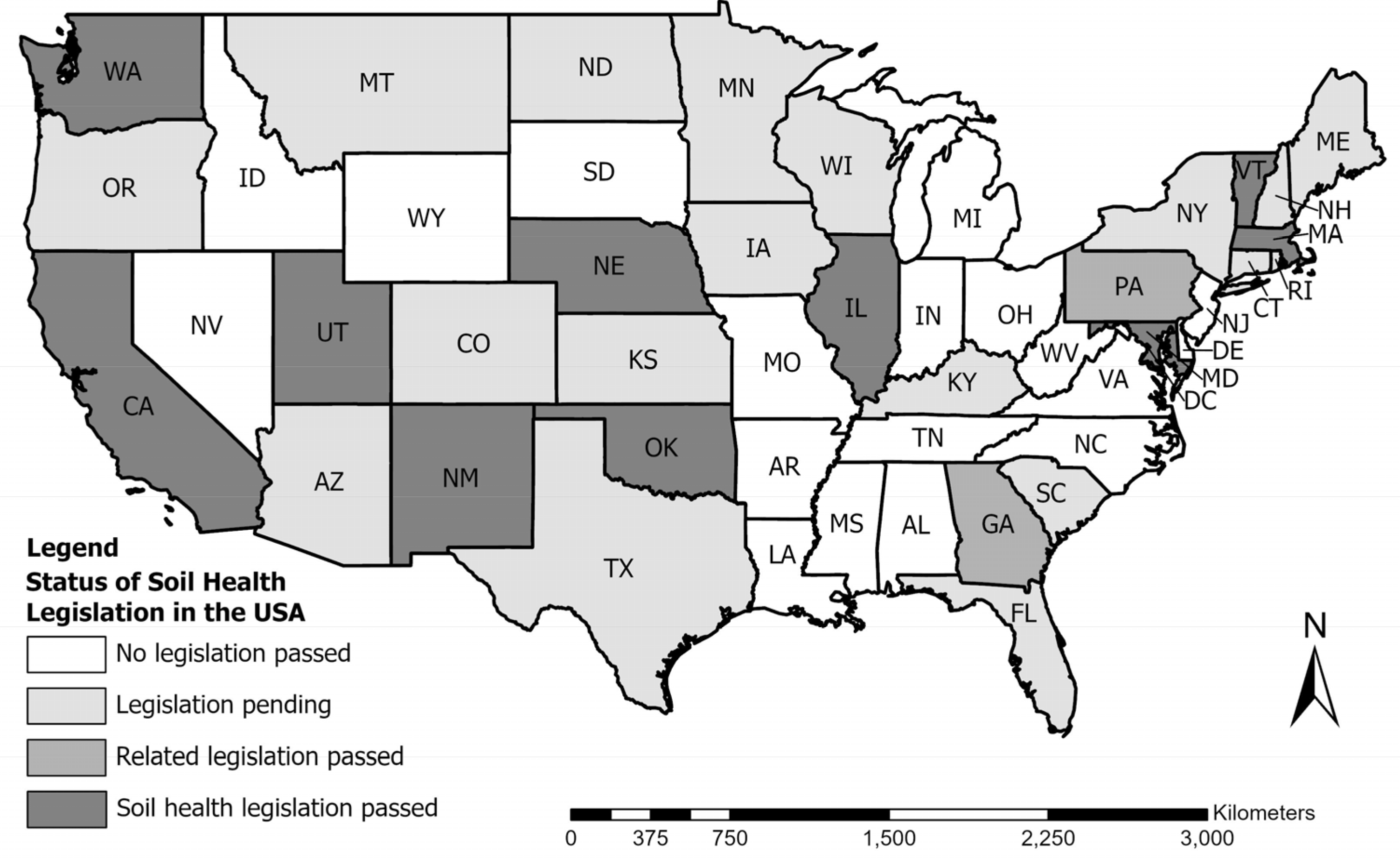
| Soil Regulating Ecosystem Services within Illinois | |||||
|---|---|---|---|---|---|
| Degree of Soil Development and Weathering | |||||
| Slight 12.1% | Moderate 87.7% | Strong 0.2% | |||
| Entisols | Inceptisols | Histosols | Alfisols | Mollisols | Ultisols |
| 7.5% | 3.9% | 0.7% | 45.1% | 42.6% | 0.2% |
 |  |  |  |  |  |
| Midpoint storage and social cost of soil organic carbon (SOC): 1.4× 1012 kg C, $232.4B | |||||
| 7.5 × 1010 kg | 4.3 × 1011 kg | 1.2 × 1011 kg | 4.2 × 1011 kg | 7.1 × 1011 kg | 1.4 × 109 kg |
| $12.7B | $7.2B | $20.7B | $71.1B | $120.4B | $229.1M |
| 5.5% | 3.1% | 8.9% | 30.6% | 51.8% | 0.1% |
| Midpoint storage and social cost of soil inorganic carbon (SIC): 9.2× 1011 kg C, $154.5B | |||||
| 4.5 × 1010 kg | 2.5 × 1010 kg | 2.1 × 109 kg | 2.4 × 1011 kg | 6.1 × 1011 kg | 0 |
| $7.7B | $4.1B | $359.6M | $40.3B | $101.9B | $0 |
| 5.0% | 2.7% | 0.2% | 26.1% | 66.0% | 0% |
| Midpoint storage and social cost of total soil carbon (TSC): 2.3 × 1012 kg C, $386.9B | |||||
| 1.2 × 1011 kg | 6.8 × 1010 kg | 1.2 × 1011 kg | 6.6 × 1011 kg | 1.3 × 1012 kg | 1.4 × 109 kg |
| $20.4B | $11.4B | $21.1B | $111.4B | $222.3B | $229.1M |
| 5.3% | 2.9% | 5.4% | 28.8% | 57.5% | 0.1% |
| Sensitivity to climate change | |||||
| Low | Low | High | High | High | Low |
| SOC and SIC sequestration (recarbonization) potential | |||||
| Low | Low | Low | Low | Low | Low |
| NLCD Land Cover Classes (LULC), Soil Health Continuum | 2016 Total Area by LULC (km2, %) | Degree of Weathering and Soil Development | |||||
|---|---|---|---|---|---|---|---|
| Slight | Moderate | Strong | |||||
| Entisols | Inceptisols | Histosols | Alfisols | Mollisols | Ultisols | ||
| 2016 Area by Soil Order (km2) | |||||||
| Barren land | 138.8 (0.1) | 38.3 | 8.1 | 0.9 | 30.6 | 60.8 | 0.1 |
| Woody wetlands | 2587.0 (2.1) | 719.0 | 615.5 | 85.2 | 178.3 | 988.8 | 0.2 |
| Shrub/Scrub | 64.6 (0.1) | 10.5 | 3.0 | 0.4 | 36.5 | 14.0 | 0.1 |
| Mixed forest | 4555.6 (3.7) | 521.8 | 258.6 | 3.9 | 3087.3 | 674.7 | 9.3 |
| Deciduous forest | 14,318.3 (11.5) | 1666.2 | 1422.4 | 49.9 | 9380.4 | 1630.4 | 169.1 |
| Herbaceous | 473.2 (0.4) | 112.9 | 13.8 | 8.2 | 161.8 | 176.2 | 0.2 |
| Evergreen forest | 172.9 (0.1) | 20.5 | 3.9 | 0.3 | 131.0 | 15.5 | 1.7 |
| Emergent herbaceous wetlands | 458.0 (0.4) | 124.8 | 56.5 | 48.5 | 12.4 | 215.9 | 0.0 |
| Hay/Pasture | 9342.2 (7.5) | 834.0 | 399.4 | 33.9 | 6498.9 | 1569.7 | 6.3 |
| Cultivated crops | 78,631.4 (63.4) | 3132.8 | 1837.0 | 520.8 | 31,075.1 | 42,064.7 | 1.0 |
| Developed, open space | 5091.8 (4.1) | 388.3 | 130.2 | 53.2 | 2564.1 | 1953.2 | 2.7 |
| Developed, medium intensity | 2031.7 (1.6) | 668.2 | 9.9 | 15.4 | 524.7 | 813.5 | 0.0 |
| Developed, low intensity | 5422.9 (4.4) | 752.0 | 62.6 | 49.6 | 2182.3 | 2376.2 | 0.2 |
| Developed, high intensity | 814.6 (0.7) | 431.1 | 1.5 | 6.8 | 120.4 | 254.8 | 0.0 |
| Totals | 124,103.1 (100%) | 9420.5 | 4822.5 | 877.0 | 55,983.9 | 52,808.2 | 190.9 |
| NLCD Land Cover Classes (LULC), Soil Health Continuum Dynamics | Change in Area, 2001–2016 (%) | Degree of Weathering and Soil Development | |||||
|---|---|---|---|---|---|---|---|
| Slight | Moderate | Strong | |||||
| Entisols | Inceptisols | Histosols | Alfisols | Mollisols | Ultisols | ||
| Change in Area, 2001–2016 (%) | |||||||
| Barren land | 1.9 | 5.9 | 88.5 | 19.1 | −11.9 | 1.1 | 6.8 |
| Woody wetlands | −1.0 | −1.1 | −0.5 | 1.5 | −0.8 | −1.4 | 0.5 |
| Shrub/Scrub | 118.6 | 89.6 | 34.2 | 21.6 | 173.6 | 75.3 | 57.4 |
| Mixed forest | 0.5 | 0.7 | 0.8 | −7.7 | 0.6 | −0.1 | 0.9 |
| Deciduous forest | −0.6 | −0.3 | 0.1 | −5.0 | −0.6 | −1.5 | 0.0 |
| Herbaceous | −2.6 | −2.3 | 28.6 | −18.7 | 12.0 | −13.9 | −4.3 |
| Evergreen forest | −0.8 | −1.7 | 1.2 | −6.1 | −0.1 | −5.6 | 1.2 |
| Emergent herbaceous wetlands | −6.6 | −12.1 | −1.7 | −2.0 | 0.9 | −5.7 | −83.3 |
| Hay/Pasture | −7.3 | −7.3 | −7.0 | −15.1 | −7.2 | −7.6 | −5.1 |
| Cultivated crops | 0.0 | 0.1 | 0.6 | −0.9 | 0.9 | −0.6 | 9.1 |
| Developed, open space | 4.2 | 2.5 | 1.1 | 13.7 | 3.0 | 6.0 | 0.2 |
| Developed, medium intensity | 11.3 | 3.8 | 11.7 | 19.1 | 13.3 | 16.7 | 0.0 |
| Developed, low intensity | 3.7 | 0.2 | 1.3 | 8.5 | 3.1 | 5.5 | 0.0 |
| Developed, high intensity | 16.7 | 5.3 | 30.1 | 23.7 | 28.8 | 35.2 | 100.0 |
| NLCD Land Cover Classes (LULC); Developed Area Increase between 2001 and 2016 (km2); Midpoint Complete Loss of Total Soil Carbon (kg); Midpoint SC-CO2 ($ = USD) | Degree of Weathering and Soil Development | |||||
|---|---|---|---|---|---|---|
| Slight | Moderate | Strong | ||||
| Entisols | Inceptisols | Histosols | Alfisols | Mollisols | Ultisols | |
| Developed Area Increase between 2001 and 2016 (km2) Midpoint Complete Loss of Total Soil Carbon (kg) Midpoint SC-CO2 ($ = USD) | ||||||
| Developed, open space | 9.6 | 1.4 | 6.4 | 74.7 | 111.3 | 0.0 |
| 203.5 km2 (4.7 × 109 kg C) | 1.2 × 108 | 2.0 × 107 | 9.1 × 108 | 8.8 × 108 | 2.8 × 109 | 0.0 |
| $795.2M | $20.8M | $3.3M | $153.8M | $148.7M | $468.6M | 0.0 |
| Developed, medium intensity | 24.3 | 1.0 | 2.5 | 61.6 | 116.5 | 0.0 |
| 206.0 km2 (4.3 × 109 kg C) | 3.1 × 108 | 1.4 × 107 | 3.6 × 108 | 7.3 × 108 | 2.9 × 109 | 0.0 |
| $728.2M | $52.7M | $2.4M | $60.1M | $122.6M | $490.5M | 0.0 |
| Developed, low intensity | 1.8 | 0.8 | 3.9 | 65.3 | 124.1 | 0.0 |
| 195.9 km2 (4.5 × 109 kg C) | 2.3 × 107 | 1.1 × 107 | 5.6 × 108 | 7.7 × 108 | 3.1 × 109 | 0.0 |
| $751.9M | $3.9M | $1.9M | $93.7M | $129.9M | $522.5M | 0.0 |
| Developed, high intensity | 21.6 | 0.3 | 1.3 | 26.9 | 66.3 | 0.0 |
| 116.5 km2 (2.4 × 109 kg C) | 2.8 × 108 | 4.2 × 106 | 1.9 × 108 | 3.2 × 108 | 1.7 × 109 | 0.0 |
| $411.5M | $46.9M | $708,000.0 | $31.2M | $53.5M | $279.1M | 0.0 |
| Totals | 57.4 | 3.6 | 14.0 | 228.6 | 418.3 | 0.0 |
| 721.8 km2 (1.6 × 1010 kg C) | 7.3 × 108 | 5.0 × 107 | 2.0 × 109 | 2.7 × 109 | 1.0 × 1010 | 0.0 |
| $2.7B | $124.6M | $8.5M | $336.4M | $454.9M | $1.8B | 0.0 |
| NLCD Land Cover Classes (LULC), Soil Health Continuum Dynamics | Change in Area, 2001–2016 (%) | Degree of Weathering and Soil Development | |||||
|---|---|---|---|---|---|---|---|
| Slight | Moderate | Strong | |||||
| Entisols | Inceptisols | Histosols | Alfisols | Mollisols | Ultisols | ||
| Change in Area, 2001–2016 (%) | |||||||
| Barren land | −67.5 | −37.9 | −97.9 | −76.8 | −76.0 | −75.6 | 0.0 |
| Woody wetlands | 0.5 | −3.9 | −90.0 | 2.2 | −5.0 | 1.0 | 0.0 |
| Shrub/Scrub | −1.9 | −12.6 | −20.0 | 61.3 | 3.7 | −10.2 | 0.0 |
| Mixed forest | −10.7 | −7.8 | −40.0 | −16.1 | −9.6 | −12.6 | 0.0 |
| Deciduous forest | −7.4 | −7.5 | −13.1 | −8.0 | −6.9 | −7.8 | 0.0 |
| Herbaceous | −26.0 | −24.8 | −34.9 | −32.6 | −25.4 | −25.8 | 0.0 |
| Evergreen forest | −6.4 | −0.6 | 0.0 | −20.0 | −7.0 | −8.9 | 0.0 |
| Emergent herbaceous wetlands | −4.0 | −9.1 | 0.0 | −2.1 | −8.4 | −4.2 | 0.0 |
| Hay/Pasture | −13.1 | −11.8 | −7.3 | −16.6 | −11.6 | −15.6 | 0.0 |
| Cultivated crops | −18.1 | −14.0 | −27.9 | −20.5 | −17.1 | −20.6 | 0.0 |
| Developed, open space | 12.9 | 15.0 | 68.3 | 14.6 | 12.1 | 12.6 | 0.0 |
| Developed, medium intensity | 13.5 | 13.2 | 14.4 | 14.0 | 13.9 | 13.2 | 0.0 |
| Developed, low intensity | 6.6 | 7.4 | 17.0 | 7.5 | 6.0 | 6.7 | 0.0 |
| Developed, high intensity | 17.8 | 12.3 | 46.2 | 14.7 | 21.4 | 19.5 | 0.0 |
| Illinois Economic Development Regions | Past Developments (through 2016) | Recent Developments (2001–2016) | ||||
|---|---|---|---|---|---|---|
| Area (km2) | Midpoint TSC Loss (kg) | Midpoint SC-CO2 ($) | Area (km2) | Midpoint TSC Loss (kg) | Midpoint SC-CO2 ($) | |
| Northeast | 4488.0 | 9.2 × 1010 | $15.4B | 451.4 | 1.1 × 1010 | $1.8B |
| Northern Stateline | 612.5 | 1.3 × 1010 | $2.3B | 45.5 | 1.1 × 109 | $190.9M |
| Northwest | 1101.2 | 2.2 × 1010 | $3.8B | 30.9 | 6.3 × 108 | $106.7M |
| East Central | 737.5 | 1.7 × 1010 | $2.8B | 21.0 | 4.7 × 108 | $78.9M |
| North Central | 1126.8 | 2.3 × 1010 | $3.8B | 41.8 | 7.9 × 108 | $133.6M |
| West Central | 698.7 | 1.2 × 1010 | $2.1B | 9.9 | 1.6 × 108 | $27.1M |
| Central | 1197.1 | 2.2 × 1010 | $3.7B | 29.3 | 5.1 × 108 | $86.5M |
| Southeast | 1026.2 | 1.5 × 1010 | $2.5B | 11.2 | 1.7 × 108 | $27.9M |
| Southwest | 1180.8 | 1.8 × 1010 | $3.0B | 83.5 | 1.4 × 109 | $236.8M |
| Southern | 1228.2 | 1.6 × 1010 | $2.6B | 14.6 | 1.8 × 108 | $30.8M |
| Total | 13,397.0 | 2.5 × 1011 | $41.9B | 738.9 | 1.6 × 1010 | $2.7B |
Disclaimer/Publisher’s Note: The statements, opinions and data contained in all publications are solely those of the individual author(s) and contributor(s) and not of MDPI and/or the editor(s). MDPI and/or the editor(s) disclaim responsibility for any injury to people or property resulting from any ideas, methods, instructions or products referred to in the content. |
© 2023 by the authors. Licensee MDPI, Basel, Switzerland. This article is an open access article distributed under the terms and conditions of the Creative Commons Attribution (CC BY) license (https://creativecommons.org/licenses/by/4.0/).
Share and Cite
Mikhailova, E.A.; Zurqani, H.A.; Lin, L.; Hao, Z.; Post, C.J.; Schlautman, M.A.; Post, G.C.; Shepherd, G.B.; Dixon, R.M. Quantifying Damages to Soil Health and Emissions from Land Development in the State of Illinois (USA). Land 2023, 12, 1567. https://doi.org/10.3390/land12081567
Mikhailova EA, Zurqani HA, Lin L, Hao Z, Post CJ, Schlautman MA, Post GC, Shepherd GB, Dixon RM. Quantifying Damages to Soil Health and Emissions from Land Development in the State of Illinois (USA). Land. 2023; 12(8):1567. https://doi.org/10.3390/land12081567
Chicago/Turabian StyleMikhailova, Elena A., Hamdi A. Zurqani, Lili Lin, Zhenbang Hao, Christopher J. Post, Mark A. Schlautman, Gregory C. Post, George B. Shepherd, and Renee M. Dixon. 2023. "Quantifying Damages to Soil Health and Emissions from Land Development in the State of Illinois (USA)" Land 12, no. 8: 1567. https://doi.org/10.3390/land12081567
APA StyleMikhailova, E. A., Zurqani, H. A., Lin, L., Hao, Z., Post, C. J., Schlautman, M. A., Post, G. C., Shepherd, G. B., & Dixon, R. M. (2023). Quantifying Damages to Soil Health and Emissions from Land Development in the State of Illinois (USA). Land, 12(8), 1567. https://doi.org/10.3390/land12081567










